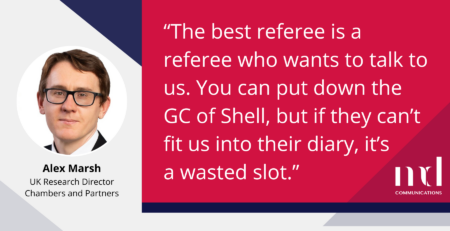We are just a year on from the last MD Communications white paper on the directories. In year one we had found people keen – hungry, even – to let us know what they thought and then to scrutinise and talk about the experience of others in the legal sector who work on, and in, the directory process.
The result was an immensely popular document, requested by firms and chambers of all sizes from around the world.
Other professions don’t have anything comparable to the legal directories – which have become an ‘industry’ inside the legal sector. But would a repeat paper add anything?
If the research hadn’t yielded more than a mild update, we would probably have done an update summary. In fact, what came back crystallised our thinking on some key issues facing the legal sector.
Take technology. Are the robots coming to take all the lawyers’ jobs, as various headlines thunder? What should the use, or not, of blockchain and automation do to rankings?
And has all the broad joy of old-fashioned law been spoiled by ‘disaggregation’ and ‘northshoring’? In not tackling these issues adequately do the directories face a slow decline in their utility?
On such questions we have some reassurance for the legal directories – and by extension the legal profession.
There is a place, and an important one at that, for the personal and subjective. As tech becomes more standardised, the personal ‘feel’ of a professional service becomes more, not less, important.
One of the clearest signals from the market, for example, is that they want personal contact with, and access to, directory researchers and editors. The personal touch seen in blogs and articles from editors is a welcome innovation.
And which of the directories is on the rise? According to our research, the traditional top-two – The Legal 500 and Chambers and Partners, who are further ahead of the ‘chasing pack’ than ever, though there is plenty of room for others offering a particular perspective on parts of the legal market.
What we think is new is a degree of scrutiny for the directories themselves. There is an appetite from the market for this – we feel we found a gap in the market on doing the first white paper.
The directories have engaged with that scrutiny, and this speaks well of them. This is a transparent age, and the directories ask much in time and resource from the legal sector.
As was the case with our last white paper, we mean to assist debate around this peculiar aspect of the legal market, and once again are taking our findings to the International Bar Association annual conference in Rome.
If you couldn’t make it to Rome, but have a view or just want to know more, I hope you’ll get in touch.
White paper: Request a digital copy












